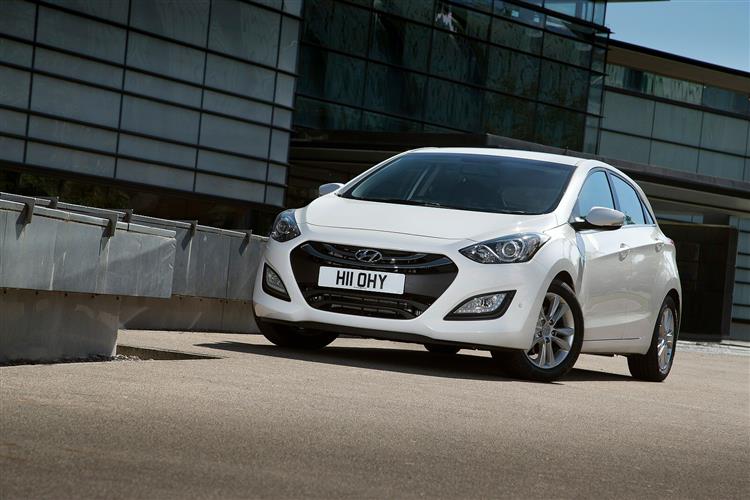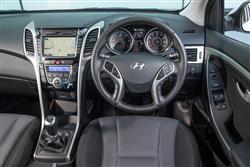LIFE BEGINS AT THIRTY (some text hidden) --NONE--
By Jonathan Crouch
Introductionword count: 87
If, in choosing a used Focus-sized Family Hatchback, you merely want to buy a very good one and pay as little as possible for it, then Hyundai has a proposition for you - its improved post-2015 second generation i30. With efficient engines, a smart look, a pokey petrol Turbo flagship model and the availability of an impressive dual-clutch 7-speed auto gearbox, it's certainly a competitive proposition. Spacious, sensibly-specced and value-laden, this is a car that offers a really good alternative to the volume brands in this segment.
Modelsword count: 14
5dr hatchback/ Tourer estate (1.4, 1.6, 1.6 turbo petrol / 1.6 CRDi diesel 110PS/136PS)
Historyword count: 246
Cast your mind back to 2007. That was the year the very first Hyundai i30 family hatchback appeared, a Focus-sized model that completely changed the way we thought about Korean cars. Since then, this Asian maker has transformed itself from budget brand to the point where it's now a mainstream quality choice, a process that was aided by the launch of the second generation i30 model in 2012, a family hatchback that did well for Hyundai on these shores. By 2015 though, this model was facing tougher competition from an army of new arrivals in the Focus and Astra segment. Hence the need for the revised second generation i30 model that we're going to evaluate here as a used car buy, a car first launched here in the Spring of 2015. It's very firmly a product of evolution rather than revolution: you'd certainly have to know the original second generation design quite well to immediately spot this improved version's differences at first glance. Delve a little deeper though and it becomes clear that the changes Hyundai made here were actually quite significant. They included an upgraded engine line-up incorporating a more efficient 1.4-litre petrol powerplant, a much higher-tech dual-clutch 7-speed automatic transmission option, a powerful flagship petrol Turbo model, luxury car-style equipment options and a smarter look to build on the brand's well-liked so-called 'Fluidic Sculpture' design philosophy. This improved MK2 model sold until 2017, when it was replaced by an all-new third generation i30 range.
What You Getword count: 1091
When Hyundai developed their very first i30 model back in 2007, they focused on getting the basic car right. Five years later though, at the launch of that design's second generation replacement, we noted that the brand had put far more work into styling and packaging, an emphasis that's paid off since, with customers apparently rating this car's pleasing design as their number one reason for purchase. There wasn't too much need then, to change things very much when in 2015, it came to this mid-term update. Nevertheless, the aesthetics were significantly refreshed to a point where this car still looks modern and current. Most of the improvements were made at the front, where jewel-like front headlamps - with optional BiXenon technology - flank a redesigned hexagonal front grille that aimed to give the car a bit of personality and on a top model was emphasised with a chrome border. Lower down to its left and right are bright LED daytime running lights, the kind of thing you get from mid-spec level upwards on most family hatchback rivals. Here, they were fitted right across the range to pierce through the gloom on overcast winter days. In profile, where you might notice the smarter wheels of this improved model, you're reminded that by 2015, the mainstream i30 range was built solely around a five-door hatchback bodystyle - though the three-door shape did live on for buyers of the rare top Turbo version. Otherwise, the i30's side view offers a better perspective on the brand's so-called 'fluidic sculpture' styling approach. It includes a subtle lower crease that flows back along the door sills to the rear wheelarch, but the theme is more obviously characterised by an emphatic upper swage line that flares out of the front wheelarch before sweeping down into restyled rear light clusters. It's even quite interesting at the rear - rather Alfa Romeo Giulietta-like, which isn't something you might be expecting to hear about a Hyundai. In contrast to the usual rather conservative approach you expect on a mainstream family hatch, there are stylistic flourishes, notably around the lower rear reflectors that flank the numberplate and in the multi-faceted tailgate. With the top Turbo variant, the finishing touches are provided by powerful twin exhausts and a neat roof spoiler. Inside the cabin, Hyundai decided few changes were needed for this post-2015 facelifted MK2 model, so few changes were made. Get a top-spec model and you can see why. True, the interior might not quite have the build solidity of a Golf or the flair of a Focus but in some respects, it's arguably a more interesting place to be than either of those cars. Add in the top Turbo variant's tinsel - alloy pedals, a red gearknob and red-stitched leather-effect trim for the door panels and the edges of these red and black sports seats - and it feels very nice indeed. True, the splashes of metallic brightwork you'll find around the dash may clearly be painted plastic but they've been carefully chosen and the floating silver spines that line the edges of the centre console are stylish and neat. They frame a smart set of ventilation controls - illuminated in a ghostly blue - that were moved further up than they would normally be on a car of this kind so that they could fall to hand more easily and free up extra storage space in front of the gearlever. There are plenty of other cubbies and compartment for clutter too, including decently-sized door pockets that will each take a 1.5-litre bottle. There's lots of room for occupants too: Hyundai boasted of significant increases in leg, shoulder and headroom for front seat occupants when this second generation i30 model was first introduced. Fit and finish from the Czech factory is also excellent - to the point where the soft-touch textures on offer around the dash show a lot of better established brands how it should be done. Only the shiny steering column stalks betray Hyundai's budget brand origins, sitting in stark contrast to the classy excellence of the 7-inch infotainment touchscreen fitted to plusher variants that get satellite navigation as standard. Get such a model and, but for the badge on the four-spoke steering wheel, you could almost think yourself to be in a car from a premium brand. Through that multi-function reach and rake-adjustable wheel, you glimpse a centre digital information display flanked by two quite deeply cowled but clearly presented dials, each with a smaller integrated circular gauge, in the rev counter for temperature and in the speedometer for fuel. So the instruments are clear - and so is all-round visibility - or at least it is to the front and to the side. Rearward visibility though, is slightly marred by the small, high and narrow rear window, an issue Hyundai was well aware of, hence the brand's decision to fit all but entry-level variants with rear parking sensors. In the rear, it's comfortable for two, but much less accommodating for three thanks to a raised centre seat cushion. Still, that's the case with most cars in the Focus-sized family hatchback segment. Three kids should be fine though and if you do have to take a trio of adults, getting them in will be made easier by the way the i30's designers managed to reduce the size of the central transmission tunnel. Rear passengers will also appreciate the provision of their own air vents, though they might be rather less keen on the rather small side windows. Out back, there's a 378-litre boot. That offers a middle ground in terms of family hatch class carrying capacity. In other words, it gives you about 25% more space than you'd get in a Ford Focus but around 25% less room than you'd find in, say, a Peugeot 308 or a Honda Civic. Ultimately though, we're talking here of a cargo area that should be quite sufficient for the needs of most likely buyers, similar in size to that you'd find in key rivals like Vauxhall's Astra, SEAT's Leon and Kia's cee'd. If you need more room and want to push the rear bench forward, you'll find that instead of the backrest merely flopping onto the seatbase, the rear seat cushion base flips up properly to facilitate an almost flat loadbay with up to 1316-litres of fresh air. If you regularly need more carrying capacity than that, then you should look at the Tourer estate model, which offers 528-litres in the boot, extendable to 1,642-litre with the rear seats folded.
To see the full road test text contact us on 0330 0020 227
Pictures (high res disabled)

.jpg)
|
.jpg)
|
.jpg)
| |||
.jpg)
|
.jpg)
|
.jpg)
| |||
.jpg)
|
.jpg)
|
.jpg)
| |||
.jpg)
|

|
Scoring (subset of scores)
Category: Compact Family Cars
| Performance | |
| Handling | |
| Comfort | |
| Space | |
| Styling, Build, Value, Equipment, Depreciation, Handling, Insurance and Total scores are available with our full data feed. | |



